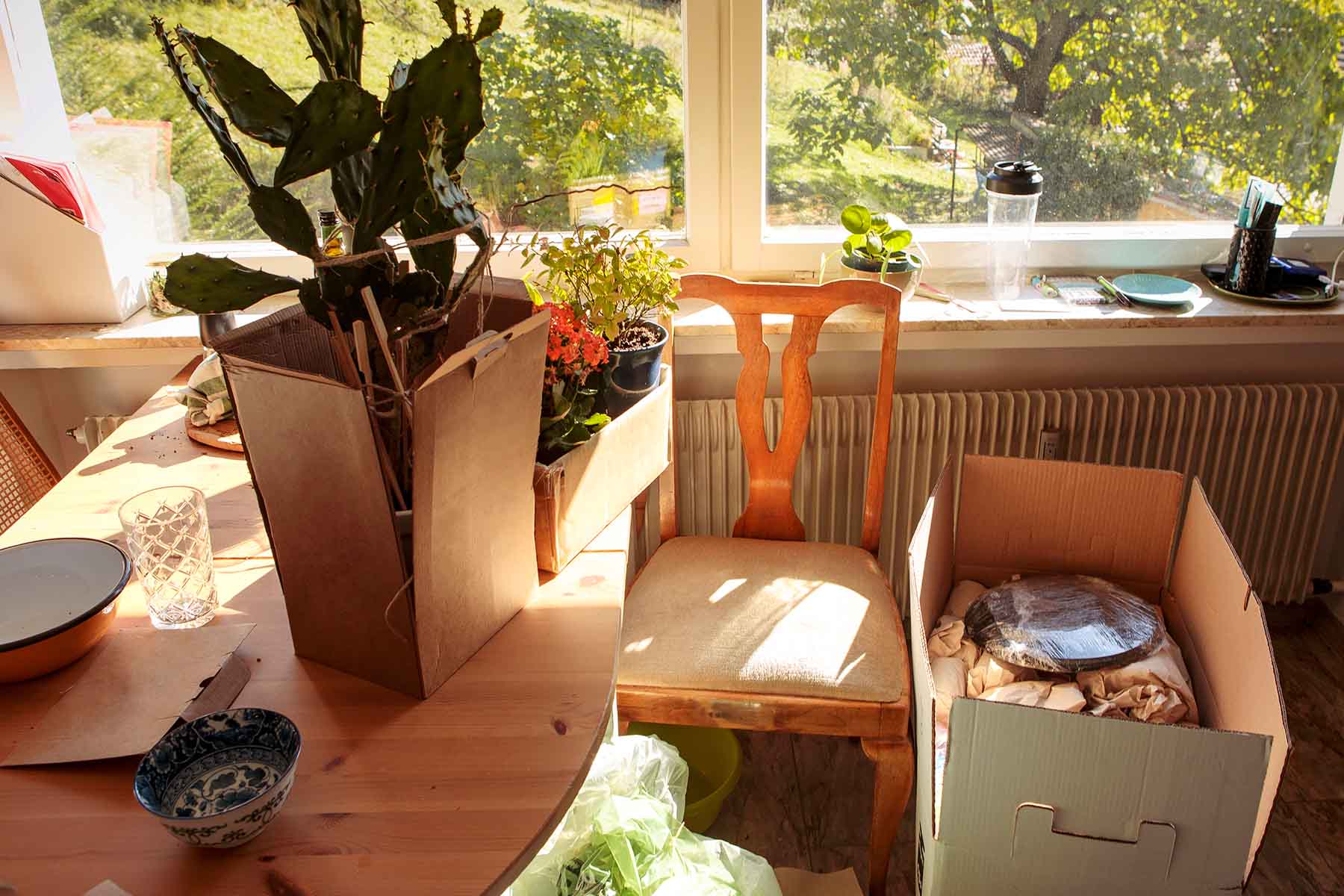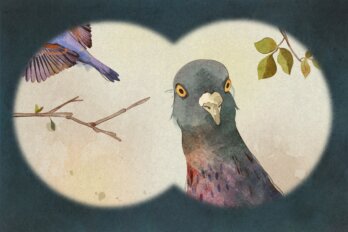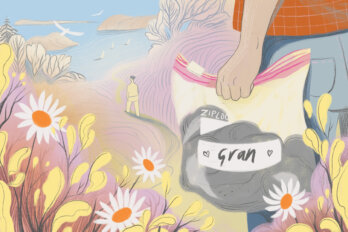My friend has been reading a book about “death cleaning.” She tells me this while we’re walking along a trail through a deep ravine, and she pauses when she says it, using air quotes around the words.
“It’s a whole thing. It’s Swedish.”
I’ve never heard of it before, but she explains the basic concept: you should minimize belongings, clean your home, and organize paperwork so that your death will be less of a burden on your children or other loved ones.
She has recently had a cancer diagnosis. It’s one of the “good ones” that is solved with surgery, no additional chemo or radiation required. Still, its impact lingers, a question now raised that won’t go away, a door that, once opened, can’t be closed again.
I ask, with some hesitation, if she’s reading the book for herself or out of general interest, though it strikes me as an odd choice to pick up at the bookstore just out of the blue.
“For me. And my parents, I guess. I mean, decluttering is good, even if you’re not about to die.”
She’s not wrong, of course. I’ve been railing to my husband about a box of ancient hardcover encyclopedias in the attic with this exact argument: After we die, one of our kids will have to decide what to do with these, and then they will feel guilty about it, so why not deal with it right now?
He’s in his early fifties but seems to have no particular worries about his own mortality: death is a thing that will happen someday, down the road, and there’s plenty of time to deal with a box of books, along with the old train tracks, a bunch of Meccano, and the yearbooks from his junior high school.
I envy this approach. I, on the other hand, fear that death may be lurking at any time, around the very next corner. It’s a joke in my family that, among my siblings and me, it’s not uncommon to answer the phone with a slightly breathy and panicked “What’s wrong?” when someone calls, though the answer is almost always benign and there is no reason to think otherwise. Waiting for the other shoe to drop—or the first shoe to drop, for that matter—is a family trait, it seems.
“Maybe I should read it,” I tell her. By now, we’re huffing back up a steep set of stairs to get to the upper lip of the ravine and back home. “Maybe I should have read it before this walk, actually.” I laugh and gasp for breath, comically clutching at my chest. “Heart attack!”
She grimaces. A few years earlier, this same friend stood in the hallway of our gym, where I’d just stepped off the treadmill because I felt “weird,” and insisted that I go see a doctor, which led to being taken by ambulance to the regional cardiac care centre.
I roll my eyes back in my head, pretend to gasp.
“Dude!” she says.
Okay, maybe not my best joke. But between the two of us, I figure we’ve earned our right to make jokes about death.
My mother was the first person I ever heard talk about “death buying”—not that she knew it, and not that death buying is “a whole thing” that a country, Scandinavian or otherwise, has enshrined into its cultural traditions.
“Well,” she said, describing how she’d landed on a particular car when she bought a new one in her late sixties. “I chose something that I thought would last long enough. It’s probably the last car I’ll ever buy.”
The last car she’d ever buy? I looked at her in surprise, frowning, scanning her from head to toe as though looking for some sign of injury or illness. Was something wrong? Was she sick? Was the other shoe about to drop?
But no. She was death buying, as I’ve come to think of it since: buying with her own future absence in mind.
“By the time this car starts giving out,” she explained, “I’ll be too old to drive anymore probably. Or . . . ” She shrugged, waving her hands in the air. “You know.”
I did know. Or she’d be gone, she meant. She wasn’t trying to be morbid or dramatic. In fact, just the opposite: it was an entirely practical thing to decide what one might need with what remained of one’s life. Why not choose accordingly?
But after the car, in the coming years, there was a growing array of purchases that were described as “the last one I’ll ever buy.” A new couch. A set of Le Creuset salt and pepper grinders. Expensive flannel sheets. On the plus side, after a life of necessary frugality (she wore the same coat the year I graduated high school as she had worn standing at the bus stop with me in kindergarten), she was finally more likely to indulge a little, to buy something “fancy” or known for its durability.
It was okay to spend a little bit more now, for quality. It had to last, after all. Not forever, of course—only until she wouldn’t be here to need it.
For most of one’s life, “stuff” is temporary. You buy new fluffy towels and you know that, someday, you’ll have washed the life right out of them and they’ll start to fray and you’ll cut them up and turn them into rags and then use those rags for a painting project one weekend and they’ll be garbage. Dishes break, spoons get lost, books are borrowed by a friend and never returned. Toys are handed down to younger children, shoes lose their soles, luggage zippers break. Some things have a longer lifecycle: clothes, if chosen wisely, can last years, through many seasons and trends and countless wearings. But they, too, will eventually thin and tear. Yes, a few objects will outlast us; we can imagine our jewellery going on to children or grandchildren, and a solid hammer can be handed down over a few generations. But most of the goods that pass through our hands are short lived in the grand scheme of things. We will always need another one, of whatever we’ve just bought, at some point.
Until one day we won’t.
My mom is not the only one I know who is death buying. I’ve heard my mother-in-law, who is in her late seventies, describe things in this way. A friend of mine in his sixties, while shopping for a new coat, casually noted that if he got a good one, it’d probably last him the rest of his life.
In the past year or two, I’ve noticed it has started slipping into my own decision-making process. My couch is nearly twenty years old. It’s a huge L-shaped sectional, far too large for the small living room it fills. But it was free and in good shape when it came to us as a hand-me-down from a family member who was downsizing. I put new foam inside the cushions a few years ago, and I’ve patched several rips in the fabric. One of the legs isn’t even attached anymore but is simply wedged between the couch and the floor to give the illusion of support. For most of the pandemic, my spouse turned it into his office, so there is now a curved divot in the seat that became his work-from-home “desk.” In other words, it is in desperate need of replacement.
But I have cats. And teenagers. And every time I think about buying something new, I pause: Why not wait till the teenagers have become adults and won’t accidentally leave grilled cheese sandwiches between the cushions? Why not hold off till the cats get old and lazy and stop using the corners as scratching posts?
And if I time it right, if I wait long enough, and choose something really sturdy, it might just be the last couch I’ll ever buy.
An unexpected side effect of getting older is that you start measuring all sorts of decisions by laying them alongside your remaining time. How many books can I read in a year, and how many years do I have remaining? Is it worth reading all the way to the end of a book that I’m not really enjoying, simply because someone deemed it important or it was a bestseller or all the smart people I know have recommended it? In my teens and twenties, I had a rule that if I started a book, I’d see it through. In my thirties, I was more likely to abandon a book unless required to finish it for some obligatory commitment; I suffered through every page of a novel that I loathed, because my whole book club was reading it and I knew I’d have to discuss it (and because it was so heavily lauded that I’d have felt stupid to confess I didn’t adore it).
Now, if a book hasn’t captured me in the first chapter, sometimes even the first five pages, it gets set aside and goes back to the library. I routinely take out a stack of ten or fifteen books and return most of them unread two weeks later. The librarians must think I’m a voracious reader with no other hobbies or commitments. But the reality is there isn’t enough time left to read stuff that I don’t love, that doesn’t feel necessary and urgent and valuable.
Travel, too, becomes defined by what your time will allow: it seems delightfully feasible to see dozens of countries when you’re young (and the possibility of a lottery win is still ahead of you). Then one day you realize that you probably won’t ever get to see India after all, and the chance you’ll swim off the coast of Australia is shrinking year by year. There are only so many trips remaining that will fit your budget and the time span over which that budget must stretch. I am quite certain I will return several more times to my favourite local camping sites or to the Gulf Islands, which are only a ferry ride away, and I am sure I’ll see the far side of Canada at least one more time, if not two. But London? Miami? Tokyo? Maybe not.
Choices and experiences of all kinds begin to winnow: How many more amazing friendships will you foster? How many romantic partners might yet remain to be met? Can you still go back to school, change careers, change goals? Which of those great home-renovation projects will you get to? How about the hobbies you always wanted to take up, the things you wanted to learn? You can do some of them, of course. But you start to realize that the rest of your life—which once seemed like an endless banquet of days in which anything was possible—is a little more limited, year by year. And you have to start choosing: Which of these possibilities is most important, and which path will you take?
Ihave often believed there’s enough inside of me for a hundred lives: enough to fall in love a hundred times, to happily settle down in a hundred places, to pursue a hundred different passions, to see the sun set on a hundred different horizons. There’s enough desire and want and curiosity inside of me, it seems, for maybe even a thousand lives. I understand now that the times I have felt most unhappy, most anxious, were the times when a choice had to be made, an entire fork in the road crossed off the map. Sometimes you can double back, try again, make a change, but not always. One kind of life precludes another, one choice limits all subsequent choices. The slow dawning realization that every step I make is determining which one single life I will have to squeeze my existence into has been, at times, a hard revelation.
My husband once found me sitting inside the closet, a pile of Kleenex next to me, the tail end of a hard cry trailing off into hiccupping sniffles. He was frantic to understand the source, to figure out the problem and then solve it, hopefully with some kind of tool or glue or other practical hands-on repair.
But there was no way to explain it. How do you tell someone that you love this exact life you have—the one where you’re sitting on the closet floor with a husband who is trying to figure out which screwdriver will fix whatever is broken, listening to your children down the hall play the same song on the recorder for the millionth time that day, with dishes piled in the sink from the food that fills your fridge, a bounty you know you are beyond privileged to have—while somehow grieving all the other lives you might have had but won’t?
It sounds selfish, the greedy wish of a child on their birthday who stomps their feet when there are not enough gifts to meet their expectations. But saying goodbye to the other versions of you that might have existed along a different set of choices is a kind of grief. At least for a little while.
There’s a transition point when you are no longer young enough to believe your time will never run out and you’re not quite old enough to be entirely pragmatic about the time that remains. That’s where I am right now, in the in-between. Sure, I can joke about death cleaning, and I can imagine that my next couch might be my final one, but I’m still getting comfortable with my mortality, still learning how to let go of the other possibilities my life might have held, still leaning into measuring what I most want against the time that remains.
But I understand a little more, month by month, year by year, the kind of peace that comes with not being afraid of the end, of knowing not just intellectually but in a bone-deep way that you will not, in fact, be the only person who ever lived who gets to skip out on the finale.
Excerpted from Halfway Home: Thoughts from Midlife by Christina Myers. Copyright © 2024 Christina Myers. Published by House of Anansi Press. Reproduced by arrangement with House of Anansi Press. All rights reserved.





